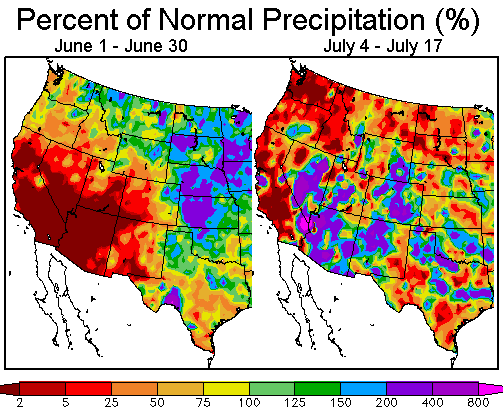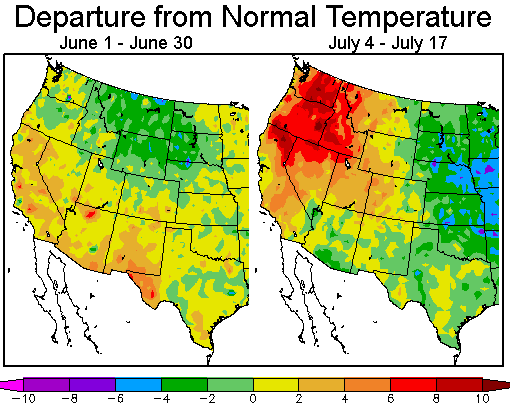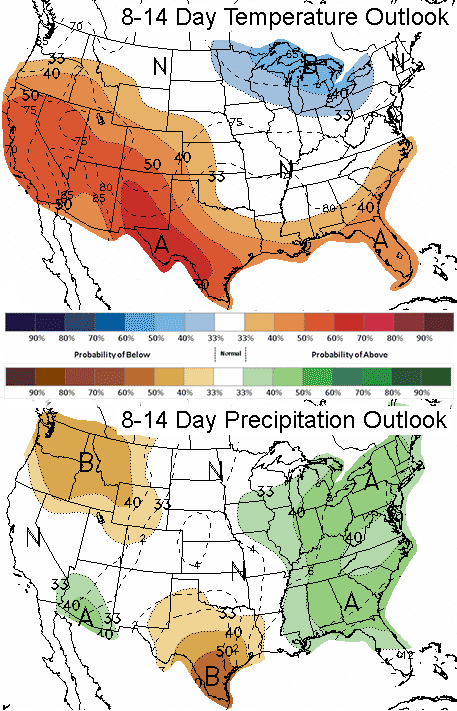Southwest Climate Outlook July 2014
Originally published in the Southwest Climate Outlook, released the 3rd Thursday of every month. Sign up for email newsletter version.

Precipitation: June was very dry, with little to no precipitation save for remnant moisture from Hurricane Cristina. An on-time start to the monsoon led to above-average precipitation in the first two weeks of July in parts of Arizona and New Mexico. Since mid-January, most of Arizona and New Mexico have logged less than 50 percent of average precipitation.
 Temperature: Most of Arizona and New Mexico were warmer than average in June. The onset of the monsoon around July 3 has driven lower-than-average temperatures across the region.
Temperature: Most of Arizona and New Mexico were warmer than average in June. The onset of the monsoon around July 3 has driven lower-than-average temperatures across the region.
Water Supply: Total reservoir storage increased by about 1.2 million acre-feet (AF) in Arizona in June. Lake Powell rose by about 1.8 million AF and Lake Mead fell by about 394,000 AF. Storage stands at 47 percent of capacity in Arizona and is lower than it was one year ago (49 percent). In New Mexico, storage decreased by 127,000 AF in June, mostly due to a 137,000 acre-foot drop at Elephant Butte. Storage in New Mexico stands at 23 percent of capacity and is greater than it was one year ago (17 percent). (AZ Reservoir Volumes / NM Reservoir Volumes)

Drought: Moderate to extreme drought continues to cover nearly all of Arizona. More than 72 percent of the state is classified with severe drought while extreme drought covers about 16 percent of the state. Almost all of New Mexico is under moderate to exceptional drought (the highest category), with more than 77 percent of the state designated as severe and over 40 percent designated as extreme drought.
Monsoon: Monsoon storms began in southeastern Arizona around July 3, falling within the historical average onset date range. Precipitation since July 1 has been above average in many parts of southern Arizona but generally below average in southern New Mexico. (monsoon summary - July SW Climate Outlook)
Fire Summary: Between January 1 and July 14, 1,074 wildfires burned 157,497 acres in Arizona and 551 wildfires scorched 20,675 acres in New Mexico. The monsoon has brought much needed moisture and humidity to the region.

ENSO: ENSO-neutral conditions continue. The probability that an El Niño event will develop is 70 percent, increasing to 80 percent in fall and winter. Most projections, however, remain uncertain as to the overall strength of the event. (El Niño Watch - July SW Climate Outlook)
Precipitation Forecasts: Forecasts point to above-average precipitation for Arizona and New Mexico over the next three months. Given widespread drought conditions, even an average monsoon could help improve drought conditions.
Temperature Forecasts: Monsoon storm cycles introduce variability into short-term temperature patterns, but the longer-term forecasts call for equal chances for above-, below-, and near-average temperatures. These forecasts are based in part on increasing temperature trends.

